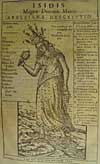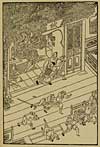Artists' Impressions
Literature was an important conduit for the notion of secret societies. From the last quarter of the eighteenth century on, good and bad writers alike introduced such organizations in widely read books, amid bands of robbers, brotherhoods, and similar groupings. The English Gothic novel often painted religious orders, and above all the Inquisition, in the colours of conspiracy, although it did not reject secret societies as such. In the German lands the societies became so fashionable in literature that some scholars treat the Geheimbundroman as a genre in its own right. And when some of the organizations became more well known, their names increasingly found their way into literary works. Many of these can now be found on the Internet. Here are twelve from various external sites.
- Gotthold Ephraïm Lessing (1729-1781), Ernst und Falck, 1777
This is perhaps the best known popularization of the ideas underlying Freemasonry, as interpreted by one of the greatest representatives of the German Enlightenment. The site from Hamburg has the text of three of the five 'Masonic dialogues' that Lessing wrote. - Friedrich Schiller (1759-1805), Der Geisterseher, 1787-1789 (Projekt Gutenberg-DE)
Schiller's one and only novel, published in installments and left unfinished, is heavily influenced by the contemporaneous debate on secret societies in Germany. Cagliostro (Giuseppe/Joseph Balsamo, later the hero of the eponymous novel by Alexandre Dumas Père) figures prominently, as does the fear that the Jesuit Order, which had officially been disbanded in 1773, continued to exist underground. - Johann Wolfgang von Goethe (1749-1832), Wilhelm Meisters Lehrjahre, 1795 (Projekt Gutenberg-DE)
The Turmgesellschaft, which secretly steers Wilhelm's life and ultimately initiates him as a member, is clearly inspired - especially in its pedagogical aspect - by the Illuminati, in which Goethe had himself participated. - NN, The Mysterious Spaniard, or The Ruins of St Luke's Abbey, 1807 (The Literary Gothic) An English 'bluebook', illustrating one way in which the Illuminati earned their bloodcurdling reputation. Such cheap publications, which got their name from their blue covers (and were also known as 'penny dreadfuls' or 'shilling shockers'), contributed much to the dissemination of the stereotypes that have since been brought together under Romanticism.
- Percy Bysshe Shelley (1792-1822), St Irvyne, or The Rosicrucian, 1811 (Project Gutenberg of Australia)
One of the anonymously published Gothic novels of the young Shelley, written under the influence of such authors as Ann Radcliffe and 'Monk' Lewis, and of his father-in-law William Godwin, who had published an earlier 'Rosecrucian novel' under the title St Leon (1799). Its Rosecrucianism is chiefly apparent in the secret of eternal life; otherwise, Shelley is here as liberal with the historical truth as in his later fragmentary story of the sect of The Assassins (1814). - Stendhal (1783-1842), Vanina Vanini, 1829 (Gallica)
The theme of this tale, one of whose principal characters is a carbonaro, is how love and revolution may collide. Stendhal knew the milieu from his stay in an agitated Milan in the 1820s. The story was later included in the Chroniques italiennes. - George Sand (1804-1876), La Comtesse de Rudolstadt, 1844 (Gallica)
The sequel to Consuelo appeared in installments in the Revue indépendante, in which Sand collaborated with the socialist Pierre Leroux. The novel contains numerous references to Freemasonry, to individuals like Cagliostro or the Comte de Saint-Germain, and especially to the Illuminati, who were sympathetically, though not very precisely, depicted as the Secte des Invisibles. - Henry Murger (1822-1861), Les Buveurs d'eau, 1855 (Gallica)
The model of a 'closed brotherhood', at the same time marginal and elitist, not only existed in romantic literature, but also in the actual life of romantic artists. Murger, known from his Scènes de la vie de bohème, characteristically turned that reality once more into literature. - Benjamin Disraeli (1804-1881), Lothair, 1870 (Project Gutenberg)
This novel by the conservative prime minister of Britain is full of secret societies and a deep conviction of their profound influence on history. Disraeli was of the opinion that the phenomenon went far back in time and originated from the resistance of long-subjected tribes. - Fyodor Dostoyevskii (1821-1881), The Possessed, 1871-1872 (English translation of Besy, University of Adelaide Library)
The source of this novel can be found in reports on the activity of Sergey Nechaev and his secret society, the People's Reprisal, which had murdered an ex-member as a potential traitor. Under the pen of Dostoyevskii, Nechaev became the quintessential fanatic, for whom the end justifies all means. - Benito Pérez Galdós (1843-1920), El Grande Oriente, 1873 (Biblioteca Virtual Miguel de Cervantes)
This story from the second series of the Episodios nacionales, in which Pérez Galdós fictionalized events from Spanish history, tells the tale of the unsuccessful efforts to create a liberal regime after the Napoleonic Wars, a tale in which Freemasonry is an important aspect. - Arthur Conan Doyle (1859-1930), How the Brigadier Played for a Kingdom, 1895 (Classic Literature Library)
In addition to (and after) Sherlock Holmes, Doyle created the character of the French hussar Gerard, whose glorious career in the service of Napoleon takes him all over Europe. In this tale he is pitted against the notorious German Tugendbund. The story later appeared in the collection The Exploits of Brigadier Gerard.



